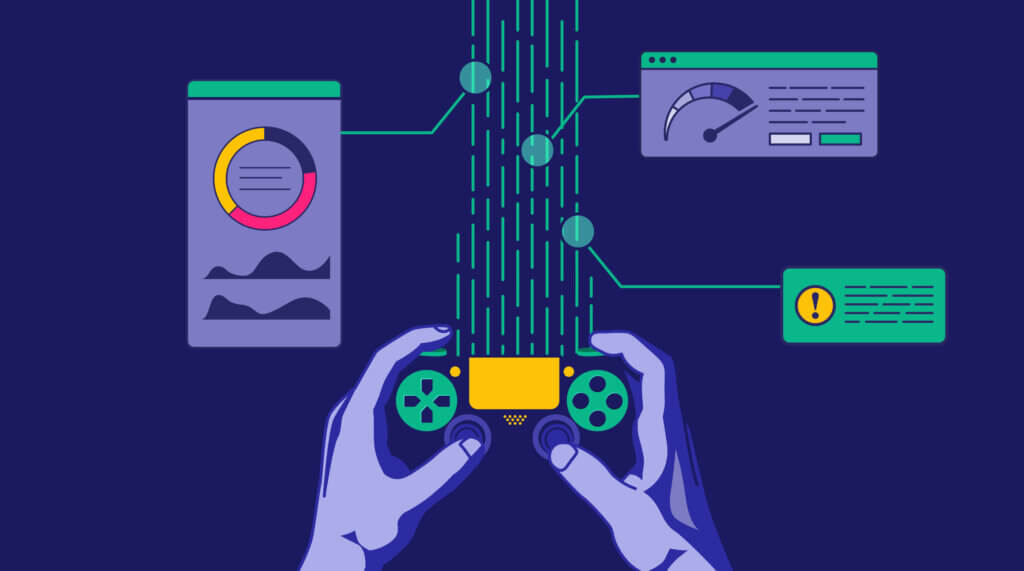Gaming Industry: The Need For CyberSecurity (Protocols)
Gaming is the largest entertainment industry worldwide, with a market worth over $197 billion USD in 2022. The pandemic has caused an enormous 26% surge in…
Whether you are just starting your observability journey or already are an expert, our courses will help advance your knowledge and practical skills.
Expert insight, best practices and information on everything related to Observability issues, trends and solutions.
Explore our guides on a broad range of observability related topics.


In today’s fast-paced and highly-competitive gaming industry, providing a seamless and enjoyable gaming experience is essential to retain users. Games need to be responsive, offer high-resolution graphics, continuous uptime, and handle a huge amount of transactions through log monitoring.
Having strong log analytics solution is essential to improve performance, identify issues, and fine-tune the player experience. From gameplay patterns to errors and failures across different layers of the software stack, logs provide valuable insights into various aspects of the game. These raw data points enable game developers to stay ahead of the curve by addressing bugs promptly and improving the game’s design.
That being said, with the sheer volume of data generated, you’ll need the right tools and strategies in place to parse through the noise and identify relevant information. This article will go over the different sources of logs, why they are important for the gaming industry and the insights they provide.
A primary source of system logs is the game engine used to build the game. The game engine captures data related to physics, rendering and game architecture. Each engine has its own way of enabling logs and configuring them, which can be found in the documentation.
There are different levels of log severity, such as “error” or “fatal” that happen when an error causes the game to crash, and “warning” which signals unwanted behavior or “info,” indicating a triggered action.
System logs are also collected by the build system that assembles the game. Logs are essential for smooth releases or deployments of the game, since they collect data about successes and issues encountered during the build process.
The game server is another significant source of logs and includes server containers, serverless functions, proxies, and CDNs, all of which are involved in delivering the game. The servers record data on user sessions, authentication, matchmaking, and in-game transactions, helping improve player experience by reducing latency, enhancing matchmaking algorithms and guaranteeing the security of user data. These improvements not only have an impact on player experience but also user retention, especially for online games.
The game’s client-side logs generated on the player’s device offer insights into in-game events, user interactions and errors encountered during gameplay. These system logs provide information that can be used to identify and fix bugs, rectify performance issues that may be specific to certain devices, operating systems or hardware configurations. This is particularly helpful for games with high-quality graphics since game developers need to get access to screen size and resolution as well as OS information to understand which aspects of the system are affecting rendering speed.
In some cases, games may rely on third-party integrations, for example for payment processing. These integrations can also provide logs, which become particularly critical if the third-party integration can strongly affect the performance of the game or deals with sensitive data. Lastly, the telemetry data generated during gameplay captures information about player actions, decisions and preferences and can help adjust the game mechanics.
A complex game can generate terabytes of logs in a relatively short period of time. It is incredibly difficult and time-consuming for an operations team to create systems from scratch to collect all the logs coming from different sources, sort through them and extract essential information. Thankfully, log management software can help overcome the challenge
Log management software offers a powerful log monitoring solution to analyze and interpret the huge amounts of data generated by the different sources of logs. The software can collect and aggregate logs in one place – and analyze them to derive valuable insights to improve the overall gaming experience. For example, some insights include identifying and resolving performance bottlenecks, uncovering potential security vulnerabilities, and pinpointing root causes of bugs or crashes.
Furthermore, they allow proactive monitoring of uptime, a vital metric for user retention. By analyzing telemetry data, log management software can also help to better understand user behavior, preferences, and engagement patterns. As a result, game developers can make data-driven decisions to refine gameplay, balance game mechanics, and optimize level design.
Log management tools assist in monitoring the efficiency of server infrastructure, ensuring optimal matchmaking and reducing latency, all of which contribute to a smoother and more enjoyable experience for the players. Overall, log management software plays a pivotal role in turning raw log data into invaluable insights, thus empowering developers to create better games and maintain high levels of player satisfaction.
Another crucial aspect of log management is addressing the signal-to-noise ratio A log management platform assists in filtering out irrelevant information, allowing developers to focus on the most pertinent data. The process becomes more efficient through the use of advanced features, such as log tagging, parsing, and customizable dashboards, which facilitate quicker identification of patterns, trends, and anomalies.

Gaming is the largest entertainment industry worldwide, with a market worth over $197 billion USD in 2022. The pandemic has caused an enormous 26% surge in…

The gaming industry delivers specialized software at scale to users who expect a flawless interface. Application performance monitoring (APM) will measure critical software performance parameters using…

The gaming industry is an extensive software market segment, reaching over $225 billion US in 2022. This staggering number represents gaming software sales to users with…
